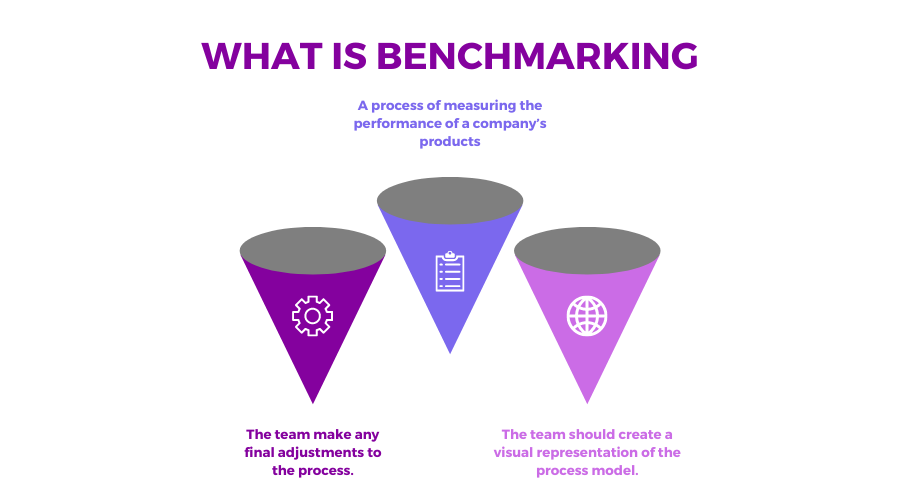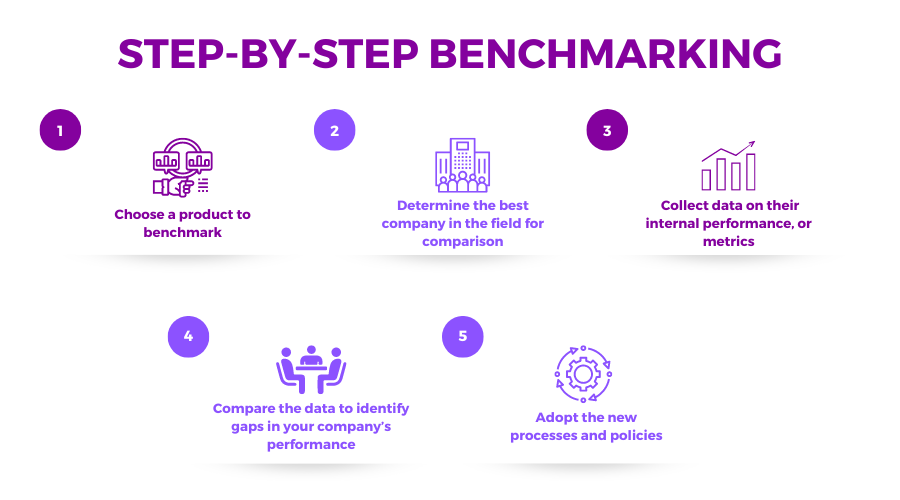
What Is a Benchmark?
Benchmarking meaning:
Benchmarking compares products, services, and operations to those of companies acknowledged as leaders in one or more areas of their business.
Do you know what can really help businesses improve their processes and systems? Benchmarking! Benchmark is a reference tool to compare your organization’s performance against the best practices in the industry.
Benchmark can also act as a great performance analyzer for product managers if combined with their product management software.
Looking for product management software that is made for product managers? Look no further than Chisel!
Chisel is the first seamless product management software made by taking feedback from real product managers.
Benchmarking includes essential information you need to see how your company stacks up against competitors. Even if they’re in a different industry or serve other clients. By using benchmarking, companies can review their own performance and pinpoint where they can make improvements.
It’s a fantastic way to stay on top of your game and keep your organization running like a well-oiled machine.

You can apply benchmarking to anything – from a specific product to an entire business function. By analyzing your company’s performance against industry data and best practices, benchmarking provides valuable insights into how well you’re doing and where there’s room for improvement.
Benchmarking Process
Here is a step-by-step guide to benchmarking:
Step 1: Planning
The first step in the benchmarking process is planning. It involves identifying what you want to improve, who you will benchmark against, and how to measure success. The planning stage will provide a roadmap for collecting the necessary information and determining what success will look like.
Step 2: Gathering Information
After planning, the next step is to collect information on your processes and how your competitors do them. It involves understanding the processes involved in the department, how calls and communication get handled, and how it differs from your competition. It is essential to gather as much information as possible.
Step 3: Data Analysis
Once you have collected the necessary information, you can start analyzing the data to identify shortcomings and opportunities for improvement. It is crucial to keep an open mind during this stage and analyze the information objectively. Once you have uncovered your findings, you can draft a report and discuss the following steps to achieve better performance.
Step 4: Action
The next step in benchmarking process is to present your findings and proposed changes to the department. Assuring that the MVP you propose is accepted and likely to achieve the success outlined in the planning stage is essential because getting buy-in from a section may require making concessions. Implementing changes is crucial to better the company in the process.
Step 5: Track the Results
No plan is complete without monitoring the results to determine its success. The only way to gauge the success of the changes is to keep an eye on the metrics and objectives for success that will get emphasized during the implementation phase. According to the desired results, monitoring can last for a brief or long time.
What Are the Benefits of Benchmarking?
Now that we looked at the benchmark definition, let us understand the benefits of benchmarking.
Benchmarking is a widespread and practical approach for establishing baselines, defining best practices, identifying improvement possibilities, and creating a competitive climate inside a business.
Benchmarking will provide vital data that will inspire conversation. It can assist firms in analyzing and prioritizing process improvements. For example, in a study conducted by Kumar and Chandra (2001), organizations that adopted benchmarking as a continuous improvement tool reported significant improvements in business operations, identifying performance shortfalls, and setting clear priorities for achieving objectives.
Benchmarking can enable you to achieve the following goals:
- Get an unbiased opinion on how well your company performs compared to others. According to an empirical study by Pemberton, Stonehouse, and Yarrow (2001), over 700 companies across manufacturing and service sectors found that benchmarking had a positive impact on their organizational performance by offering a clear comparative evaluation of their standing.
- Dig deeper into performance gaps to find areas where you can improve. A study by Maiga and Jacobs (2004) found that specific benchmarking metrics, such as annual growth in sales and profitability, had a positive and significant effect on performance improvement.
- Generate a series of standardized processes and metrics. The Balanced Scorecard (BSC), developed by Kaplan and Norton (1992), has been recognized as an effective framework for benchmarking across various organizational perspectives, such as customer, financial, and internal processes. Studies have found a positive relationship between BSC and organizational performance improvement (Hoque & James, 2000).
- Encourage a continual enhancement of mindset and culture. According to Adebanjo et al. (2010), benchmarking fosters continuous improvement by enhancing organizational learning and leading to a shift towards a culture of excellence. Organizations that practice benchmarking are able to continuously evolve by learning from industry leaders and competitors.
- Set high standards for yourself. Benchmarking helps set a high standard for performance, which encourages striving for best-in-class outcomes. Research conducted by Talib, Rahman, and Qureshi (2011) highlighted that companies using benchmarking had a greater focus on maintaining competitive advantage and continually improving their processes.
- Track and manage the performance of the company. Data from studies such as those by Galbraith and Schendel (1983) show that financial metrics like profit margins and return on assets are essential indicators of performance. However, integrating non-financial measures like customer satisfaction and internal processes is also vital for achieving holistic performance management. Companies that focus solely on financial metrics often miss out on broader organizational growth opportunities, as argued by Nicholas (1998).
By implementing benchmarking, organizations can significantly improve their performance, as demonstrated in various case studies, such as those by Wong & Wong (2008) and Panwar et al. (2013), who observed that benchmarking consistently leads to performance enhancement, increased customer satisfaction, and improved internal processes across industries.
What Are 4 Benchmarking Best Practices?
Now that we have learned benchmark meaning, benefits, and process, time to look at the best practices of benchmarking.
Start at the earliest
It’s never too soon to start benchmarking if you become the finest. Examining your competitors and determining where and how you may improve is similar to receiving a guide to your destination.
Set a Schedule for Yourself
The most challenging part of benchmarking is time allotment. Benchmarking can take a lot of time because it involves studying the competition, analyzing where changes could be made, and taking measures. Confine your benchmarking to research and actions that can be completed in the same amount of time as your company’s regular planning cycle.
Take a Look Beyond Your Sector
Companies that operate outside of your market might provide some of the most exceptional learning opportunities. One strategy is, to begin with, the issue and then discuss various industries that face the same problem but in a more advanced version.
Concentrate on the Most Critical Metrics
An organization must agree on which criteria characterizes world-class service to customers and, as a result, should be researched. Narrow your benchmarking analysis to a few common indicators or variables throughout your industry that can be evaluated for a fair comparison.

What Are the Different Types of Benchmarking?
There are four types of benchmarking:
Performance Benchmarking
This involves collecting and comparing quantitative data. It is the first step for an organization to identify performance gaps.
Example: A retail company compares its sales growth and customer satisfaction scores with those of its leading competitors to understand how it measures up and identify areas for improvement.
Practice Benchmarking
This consists of collecting and comparing qualitative information. This step-by-step analysis examines how an activity is conducted through people, processes, and technology.
Example: A manufacturing company studies its production processes against a competitor known for lean manufacturing practices. This includes analyzing defect rates, cycle times, and production costs to uncover areas for process improvements.
Internal Benchmarking
This involves comparing data from different departments, units, locations, and so on from within the organization.
Example: A large retail chain analyzes the performance of its various store locations by comparing sales and customer satisfaction scores to identify the practices of top-performing stores and replicate their success in underperforming ones.
External Benchmarking
This involves comparing your organization’s performance to other organizations in the same industry.
Example: A healthcare services provider evaluates its patient satisfaction scores and operational efficiency against leading hospitals in the region to implement strategies that improve patient outcomes and reduce costs.
FAQs
While a benchmark has a company comparing its processes, products, and operations with other entities, a key performance indicator (KPI) measures how well an individual, business unit, project, and company perform against their strategic goals.
A retail store can compare its progress by comparing its performance against some of the better performing retail stores to understand the gap between them better.
Businesses can use a benchmark in their activities to analyze themselves against some of the best internal or external standards.
Benchmarking can help measure internal progress, performance against competitors, and how your processes rank against world-class organizations.
Benchmarking compares a company’s performance to the industry’s best practices in terms of improvement. Forecasting is the finest planning technique since it allows a company to plan for the future using historical data. As opposed to benchmarking, which is used to enhance performance.
